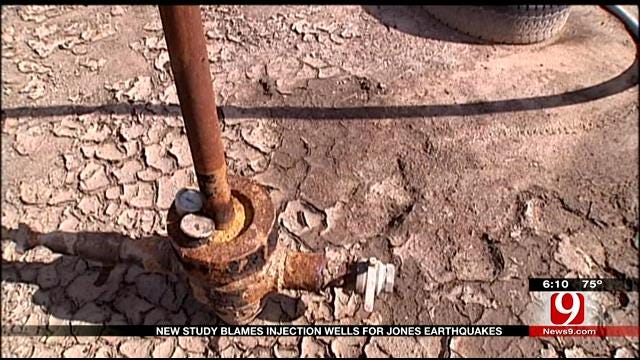Researchers: Central OK Earthquake Swarm Caused By Disposal Wells
Scientists have presented new research that concludes a dramatic increase in earthquakes in central Oklahoma is tied to a small number of high-volume disposal wells in southeast Oklahoma City.Friday, May 2nd 2014, 8:53 pm
Scientists have presented new research that concludes a dramatic increase in earthquakes in central Oklahoma is tied to a small number of high-volume disposal wells in southeast Oklahoma City.
Oil and gas industry leaders in Oklahoma cast doubt on the conclusions and call the work a "rush to judgment."
The research, led by former University of Oklahoma assistant professor of geophysics Katie Keranen, was presented yesterday at the Seismological Society of America's annual conference in Anchorage, Alaska.
Scientists have already shown, in very isolated instances, disposal wells can trigger earthquakes.
The abstract summarizing the work of Keranen, now a professor at Cornell University, and her team suggests a much broader causal relationship -- that "the Jones earthquake swarm, occurring near Oklahoma City since 2008, is linked to disposal wells."
There have been many hundreds of felt earthquakes in Jones and the surrounding area over that time frame. Prior to 2008, the region averaged less than five felt tremors per year.
In subsurface pore pressure resulting from the fluid injection is of sufficient magnitude to trigger slip on pre-existing faults. The region of increased pore pressure grows outward through time with injection. The larger, mapped faults in the subsurface may act as conduits or guides to fluid flow, and may transmit fluid pressure into basement. Our results demonstrate that wastewater disposal can raise fluid pressure and trigger earthquakes at tens of kilometers from the wellbore on existing faults.
Keranen says the data points to four wells, in particular, because of the high rate at which they inject wastewater into the subsurface. But she says, ultimately, it's a cumulative impact of all disposal wells in the area.
The researchers don't specifically name any of the wells or their owners, but say, in total, they are injecting 4 to 5 million barrels of wastewater per month "on the downthrown side of the Nemaha Fault."
In an interview over the phone, Keranen explained, "The fluid needs to move somewhere, and it just moves through the subsurface; this is a pretty permeable subsurface."
What Keranen and her team say is happening -- what no other researchers have tried to argue in the case of the Oklahoma earthquakes -- is that this enormous amount of fluid has been migrating many miles to the north, along existing fault lines, where an associated increase in fluid pressure then induces seismic events.
"Hydrogeologic modeling shows that the increase in subsurface pore pressure resulting from the fluid injection," the abstract reads, "is of sufficient magnitude to trigger slip on pre-existing faults."
"We see that in the areas where the earthquakes are happening," Keranen said, "there's an increase in fluid pressure there, and so we basically tie the fluid pressure to the earthquakes and show that there's a physical mechanism to actually trigger those earthquakes."
What's more, the researchers conclude that, over time, with continued injection of fluids at high rates, the area of increased subsurface fluid pressure expands. Keranen says this helps to explain why, to some extent, the Jones swarm has been characterized by gradual shifts outward in the areas of seismicity.
"Our results demonstrate that wastewater disposal can raise fluid pressure and trigger earthquakes at tens of kilometers from the wellbore on existing faults," the abstract concludes.
In response to the research, which has yet to be published, the Oklahoma Independent Petroleum Association released the following statement:
"Disposal wells have been used in Oklahoma for more than half a century and have met and even exceeded current disposal volumes during that time. Because crude oil and natural gas is produced in 70 of Oklahoma's 77 counties, any seismic activity within the state is likely to occur near oil and natural gas activity. Despite that, no Oklahoma-based researchers, the men and women with the greatest understanding of Oklahoma's geological structures, have definitively linked seismic activity in central Oklahoma to oil and natural gas activity. The OIPA and the oil and gas industry as a whole support the continued study of Oklahoma's increased seismic activity, but a rush to judgement provides no clear understanding of the causes."
The Oklahoma Corporation Commission, which regulates disposal wells, issued this statement:
"Obviously the Commission is very interested in any sound, peer-reviewed research on this critical topic, and has actively worked to assist researchers in this regard. The yet-to-be published study has not been shared with this agency. As the agency's hydrologists, geologists, engineers and other experts have not been given the opportunity to review any of the methodology, data, or theories of this research, the Commission therefore has no basis for comment."
More Like This
November 13th, 2024
October 28th, 2024
October 17th, 2024
Top Headlines
December 22nd, 2024
December 22nd, 2024
December 22nd, 2024










